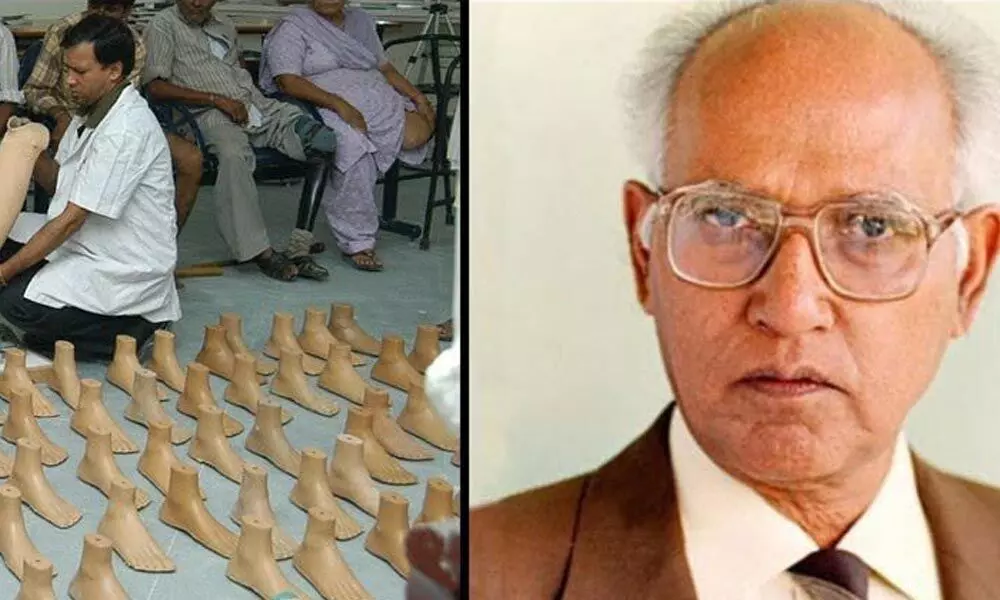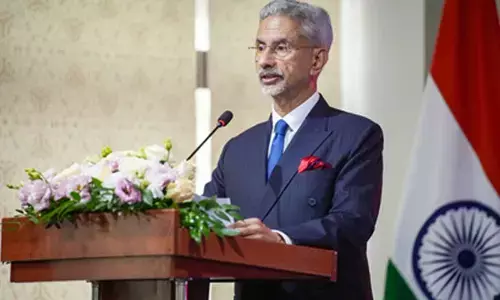Jaipur Foot and its advent in Hyderabad

Dr P K Sethi
Jaipur Foot: The western technology uses a shoe made of leather. The advantage of rubber foot is one could walk into a kitchen or a temple with it. It is cheaper and can be made by a local welder or artisan with little training. The looks are more natural. The foot is made in different Bata shoe sizes and is available in different skin colors. They are mass manufactured. Aluminum Dyes to make these were expensive. Second difficulty was aluminum welding technology
Jaipur Foot that was originated in India transformed lives of hundreds and thousands of amputees all over the world by providing them with mobility and dignity. TIME Magazine described Jaipur Foot, as the one that has revolutionized life of millions of landmine amputees. A lot of effort was put in, in the united AP, for the advent of it in Hyderabad 25 years ago, while Late Dr AP Ranga Rao was Managing Director of the Handicapped Development Corporation in early eighties of last century.
A very meticulous person Late Achanta Satyanarayana IAS was posted as Secretary Social welfare in united AP. When he was explained of Jaipur Foot by Dr Ranga Rao, he was asked to work against deadlines. Dr Ranga Rao picked up an all-round artisan who was a good craftsman, intelligent and sharp to go to Jaipur with him. The artisan also had some experience in traditional artificial limb making. Together they visited the workshop and Dr Kasliwala, a colleague of Dr Sethi who invented Jaipur Foot, spent lot of time in showing them around and explaining the concept and technical details.
Next day Dr Sethi met the Doctor and Artisan. He was a very soft-spoken person. He was a good observer. He complimented for coming with an artisan saying that Indian artisans are very good. Dr Sethi took both of them around and showed them how persons who were fitted with these gadgets were trained. There was a young dancer from Tamil Nadu who lost her lower limb in a car accident and was being fitted the device and was under training. She was practicing dancing with the new limb. Much later she acted in a Telugu film produced by Eenadu Chief Ramoji Rao as heroin dancer, which won national awards. Dr Ranga Rao also saw some young people playing football and some climbing trees. It was amazing. It was a new life to them.
Later Dr Sethi arranged a meeting with other Governing members of their team which included Dr Mehta an IAS officer, who later rose to become Deputy Governor of RBI and chairman SEBI. He was a great support to them. After a prolonged discussion they said they would impart the required training besides giving technology support to AP artisans. He however put a rider saying that, the service should be free and key doctors and artisans should be sent to Jaipur for training.
Initially they would supply a limited quantity of 'Jaipur foot' pieces at actual cost. Limitation was due to their limited capacity to produce Jaipur foot. Lack of enough dyes and high manufacturing costs of Dyes was responsible. The other condition Dr Sethi put was that the AP team should organize facilities close to hospital for free boarding and lodging to beneficiaries along with an attendant while they were undergoing training. The travel costs must be paid by the government to the beneficiary. Dr Ranga Rao assured them of all those and invited them to visit AP and satisfy themselves.
Dr Sethi was given the Ramon Magsaysay Award for his invention of Jaipur foot. Basically, the foot piece was made of galvanized Rubber which has some elasticity and is joined to a length of leg piece made of aluminum (Molded and welded into the shape of a leg piece). The stump of the amputated limb snugly fits on to the tubular hollow leg piece with some padding. The western technology uses a shoe made of leather. The advantage of rubber foot is one could walk into a kitchen or a temple with it. It is cheaper and can be made by a local welder or artisan with little training. The looks are more natural. The foot is made in different Bata shoe sizes and is available in different skin colors. They are mass manufactured. Aluminum Dyes to make these were expensive. Second difficulty was aluminum welding technology.
Incidentally, on the flight to Hyderabad Dr Ranga Rao got into conversation with a co-traveler sitting next to him. Knowing the purpose of Doctor's visit to Jaipur he got interested and told that he owns an industry in Hyderabad where they manufacture the aluminum wheels for the cars which were of low weight. It was a new technology which they pioneered in India and they were also into making of aluminum dyes. What a coincidence. His name was Galada. He said he could help in Jaipur Foot manufacturing.
Next day Dr Rao went to his office and firmed up their association and also put him in touch with Dr Sethi. Necessary orders were issued by the then AP Government for hiring space for lodging patients and costs for their food and travel etc. Nizams Institute of Medical Sciences was identified as the fitting and training center. Dr Jairam Pingle an orthopedist and few junior artisans of the workshop were requested to visit Jaipur. The artisan returned from Jaipur with few foot pieces.
A girl by name Swaroopa was referred by a doctor friend for some help. She was handicapped as she lost her lower limb in a train accident. She was an 18-year-old bubbling young lady. She discontinued her studies after the eighth standard. Dr Rao decided to get her fitted with Jaipur foot and subsequently employ her in the unit. She was very happy and agreed. The Artisan started working on her. He fitted her limb in three days and she started to practice walking. In a week's time she was walking. She was employed and soon was motivating others.
Late G Krishna a senior journalist of yesteryears then wrote a beautiful human story on her which was published in Andhra Prabha. The title was 'Swaroopaku Kalu Molichindi'. Many amputees were registering their names for fitment. As there were no more pieces of Jaipur foot the unit started manufacturing calipers. More trained handicapped persons were employed. The unit was bubbling with activity. Famous Physio Therapist Sudha Kishore was providing them with necessary physiotherapy and training. Orthopedist Jairam Pingle and his assistants, Dr BN Prasad, and Dr Narendranath would come to workshop daily and evaluate.
Dr Sethi was invited to visit Hyderabad and the unit and satisfy himself with the arrangements. He came and was highly impressed. Secretary Social Welfare Achanta interviewed Dr Sethi on AIR for 15 minutes in English which was broadcast nationwide on national hook up. Towards the end of interview Achanta asked Dr Sethi: How was it possible to replicate fitting of the limb in such a short time outside Jaipur? Dr Sethi replied: 'Dr Ranga Rao'. Achanta concluded saying, 'Yes, we have a dynamic MD'. It went on air. That year around 500 limbs were fitted, and thousands of calipers were manufactured in a unit where they were in two digits in earlier many years.
Indira Gandhi was elected as Member of Parliament from Medak. She was planning to visit Sanga Reddy to attend ZP meeting. A meeting was held to coordinate the visit and all heads of departments were invited. Dr Ranga Rao as MD Handicapped Corporation too attended the meeting. It was decided that Jaipur foot would be presented to a disabled candidate on the occasion. Mrs. Gandhi addressed the meeting.
At the end of the meeting the Jaipur foot was presented. Everyone was thrilled. Dr Ranga Rao narrating this in his Auto-Biography, 'Hopping Memories' recalled that he had the opportunity of sitting few yards away from Jawaharlal Nehru the then prime minister in a public function in Ravindra Bharathi and again participated in a meeting in official capacity with his daughter who too was Prime Minister after few decades.
That was the advent of Jaipur Foot to this part of India thanks to Dr AP Ranga Rao.
(Source: Hopping Memories By Dr Ap Ranga Rao)













